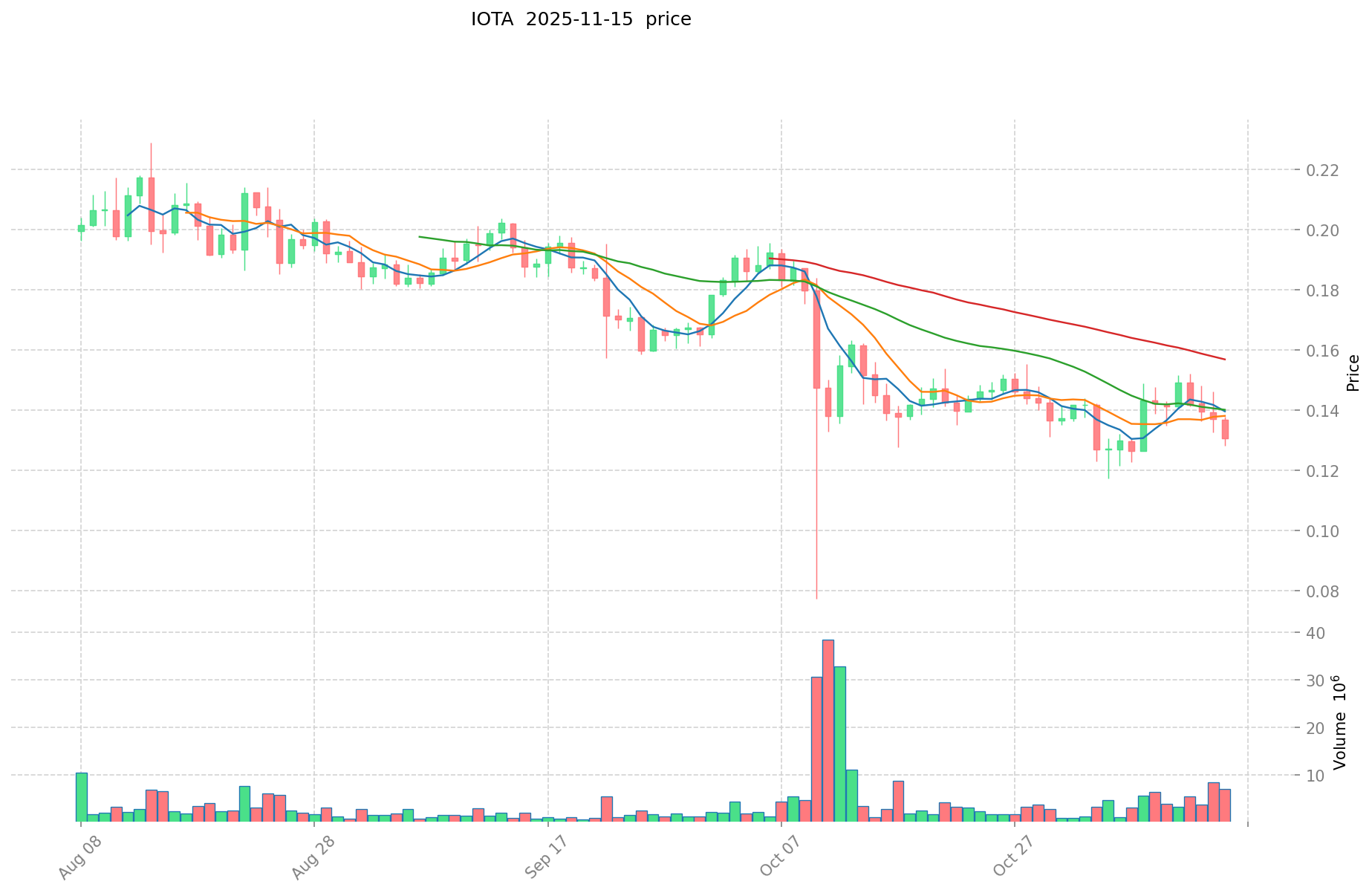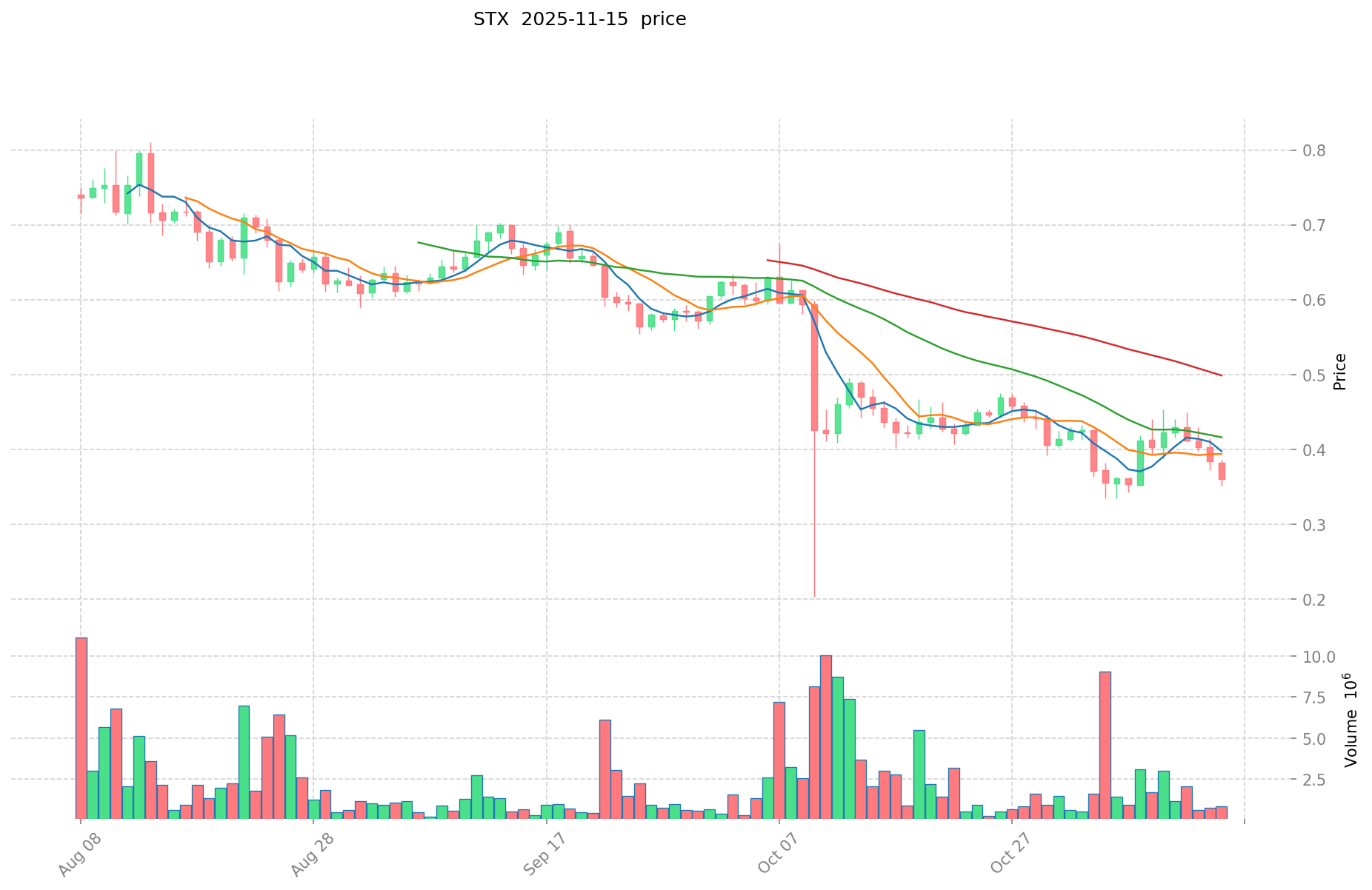IOTA vs STX: Comparing Two Innovative Blockchain Platforms for the Internet of Things
Introduction: IOTA vs STX Investment Comparison
In the cryptocurrency market, the comparison between IOTA and STX has always been a topic that investors cannot avoid. The two not only have significant differences in market cap ranking, application scenarios, and price performance, but also represent different positioning in the crypto asset space.
IOTA (IOTA): Since its launch in 2015, it has gained market recognition for its focus on machine-to-machine (M2M) transactions and the Internet of Things (IoT).
Stacks (STX): Launched in 2019, it has been hailed as a new decentralized internet for applications, aiming to give users better control over their data.
This article will comprehensively analyze the investment value comparison between IOTA and STX, focusing on historical price trends, supply mechanisms, institutional adoption, technological ecosystems, and future predictions, attempting to answer the question investors care about most:
"Which is the better buy right now?"
I. Price History Comparison and Current Market Status
IOTA (Coin A) and STX (Coin B) Historical Price Trends
- 2017: IOTA reached its all-time high of $5.25 on December 19, 2017.
- 2020: Both IOTA and STX hit their all-time lows in March 2020, with IOTA at $0.081637 and STX at $0.04559639.
- 2024: STX achieved its all-time high of $3.86 on April 1, 2024.
Current Market Situation (2025-11-15)
- IOTA current price: $0.1333
- STX current price: $0.3672
- 24-hour trading volume: IOTA $914,566.93 vs STX $308,702.76
- Market Sentiment Index (Fear & Greed Index): 10 (Extreme Fear)
Click to view real-time prices:
- Check IOTA's current price Market Price
- Check STX's current price Market Price


II. Core Factors Affecting the Investment Value of IOTA vs STX
Supply Mechanism Comparison (Tokenomics)
- IOTA: Fixed maximum supply of 2,779,530,283 MIOTA with no inflation
- STX: Hard cap of 1.818 billion tokens with declining inflation through Bitcoin halving cycles
- 📌 Historical Pattern: Fixed supply tokens like IOTA typically show higher price volatility during bull markets, while STX's declining emission model creates cyclical scarcity aligned with Bitcoin halvings.
Institutional Adoption and Market Applications
- Institutional Holdings: STX has gained more institutional traction due to Bitcoin ecosystem integration
- Enterprise Adoption: IOTA focuses on IoT, industrial applications and partnerships with companies like Jaguar Land Rover; STX targets Bitcoin-based financial applications and Web3 infrastructure
- National Policies: IOTA has stronger regulatory positioning in EU markets, while STX faces clearer regulatory frameworks in US markets as a utility token
Technical Development and Ecosystem Building
- IOTA Technical Upgrades: Transition to IOTA 2.0 (Coordicide) eliminating the centralized coordinator, implementing sharding solutions
- STX Technical Development: Nakamoto upgrade improving throughput and finality, focus on Bitcoin L2 capabilities
- Ecosystem Comparison: IOTA emphasizes industrial IoT applications and sustainable DeFi; STX excels in Bitcoin-based DeFi protocols, NFTs through Ordinals, and smart contract functionality through Clarity language
Macroeconomic Factors and Market Cycles
- Performance in Inflationary Environments: STX demonstrates stronger correlation with Bitcoin's inflation hedge properties
- Macroeconomic Monetary Policy: Interest rate hikes typically impact both assets negatively, though STX shows stronger resilience during Bitcoin uptrends
- Geopolitical Factors: IOTA's feeless structure potentially offers advantages for cross-border IoT applications, while STX benefits from Bitcoin's growing adoption as a geopolitical hedge
III. 2025-2030 Price Prediction: IOTA vs STX
Short-term Prediction (2025)
- IOTA: Conservative $0.078-$0.133 | Optimistic $0.133-$0.149
- STX: Conservative $0.324-$0.368 | Optimistic $0.368-$0.512
Mid-term Prediction (2027)
- IOTA may enter a growth phase, with estimated prices of $0.117-$0.224
- STX may enter a bullish market, with estimated prices of $0.456-$0.642
- Key drivers: Institutional capital inflow, ETF, ecosystem development
Long-term Prediction (2030)
- IOTA: Base scenario $0.212-$0.247 | Optimistic scenario $0.247-$0.304
- STX: Base scenario $0.675-$0.844 | Optimistic scenario $0.844-$1.148
Disclaimer: This analysis is for informational purposes only and should not be considered as financial advice. Cryptocurrency markets are highly volatile and unpredictable. Always conduct your own research before making any investment decisions.
IOTA:
| 年份 | 预测最高价 | 预测平均价格 | 预测最低价 | 涨跌幅 |
|---|---|---|---|---|
| 2025 | 0.149296 | 0.1333 | 0.078647 | 0 |
| 2026 | 0.17944846 | 0.141298 | 0.09043072 | 6 |
| 2027 | 0.224522522 | 0.16037323 | 0.1170724579 | 20 |
| 2028 | 0.26750254764 | 0.192447876 | 0.12124216188 | 44 |
| 2029 | 0.264471493593 | 0.22997521182 | 0.2138769469926 | 72 |
| 2030 | 0.304084723828995 | 0.2472233527065 | 0.21261208332759 | 85 |
STX:
| 年份 | 预测最高价 | 预测平均价格 | 预测最低价 | 涨跌幅 |
|---|---|---|---|---|
| 2025 | 0.512493 | 0.3687 | 0.324456 | 0 |
| 2026 | 0.621241065 | 0.4405965 | 0.31722948 | 19 |
| 2027 | 0.642411726825 | 0.5309187825 | 0.45659015295 | 44 |
| 2028 | 0.844797966714 | 0.5866652546625 | 0.451732246090125 | 59 |
| 2029 | 0.97339499053602 | 0.71573161068825 | 0.579742604657482 | 94 |
| 2030 | 1.148606088832503 | 0.844563300612135 | 0.675650640489708 | 130 |
IV. Investment Strategy Comparison: IOTA vs STX
Long-term vs Short-term Investment Strategies
- IOTA: Suitable for investors focused on IoT applications and industrial partnerships
- STX: Suitable for investors interested in Bitcoin ecosystem integration and Web3 infrastructure
Risk Management and Asset Allocation
- Conservative investors: IOTA: 30% vs STX: 70%
- Aggressive investors: IOTA: 60% vs STX: 40%
- Hedging tools: Stablecoin allocation, options, cross-currency portfolio
V. Potential Risk Comparison
Market Risks
- IOTA: Higher volatility due to fixed supply and IoT market adoption uncertainties
- STX: Dependency on Bitcoin market cycles and sentiment
Technical Risks
- IOTA: Scalability, network stability during transition to IOTA 2.0
- STX: Mining concentration, potential security vulnerabilities in smart contracts
Regulatory Risks
- Global regulatory policies may impact IOTA and STX differently, with IOTA potentially facing more scrutiny in IoT applications and STX in DeFi and Bitcoin-related regulations
VI. Conclusion: Which Is the Better Buy?
📌 Investment Value Summary:
- IOTA advantages: Feeless transactions, strong positioning in IoT and industrial applications
- STX advantages: Bitcoin ecosystem integration, declining inflation model, institutional interest
✅ Investment Recommendations:
- New investors: Consider a balanced approach, leaning towards STX for its Bitcoin ecosystem connection
- Experienced investors: Explore opportunities in both, with a focus on IOTA's IoT potential and STX's DeFi applications
- Institutional investors: Evaluate STX for its Bitcoin-related properties and IOTA for long-term IoT industry disruption potential
⚠️ Risk Warning: The cryptocurrency market is highly volatile. This article does not constitute investment advice. None
VII. FAQ
Q1: What are the main differences between IOTA and STX? A: IOTA focuses on IoT and machine-to-machine transactions, while STX targets Bitcoin-based applications and Web3 infrastructure. IOTA has a fixed supply, whereas STX has a declining inflation model aligned with Bitcoin halving cycles.
Q2: Which cryptocurrency has shown better price performance recently? A: Based on the current market data, STX has shown better recent price performance with a current price of $0.3672 compared to IOTA's $0.1333.
Q3: How do the supply mechanisms of IOTA and STX differ? A: IOTA has a fixed maximum supply of 2,779,530,283 MIOTA with no inflation. STX has a hard cap of 1.818 billion tokens with declining inflation through Bitcoin halving cycles.
Q4: What are the key factors affecting the investment value of IOTA and STX? A: Key factors include supply mechanisms, institutional adoption, market applications, technical development, ecosystem building, and macroeconomic factors such as inflation and interest rates.
Q5: What are the long-term price predictions for IOTA and STX by 2030? A: For IOTA, the base scenario predicts $0.212-$0.247, with an optimistic scenario of $0.247-$0.304. For STX, the base scenario predicts $0.675-$0.844, with an optimistic scenario of $0.844-$1.148.
Q6: How do the investment strategies for IOTA and STX differ? A: IOTA is suitable for investors focused on IoT applications and industrial partnerships, while STX is suitable for those interested in Bitcoin ecosystem integration and Web3 infrastructure. Conservative investors might allocate 30% to IOTA and 70% to STX, while aggressive investors might allocate 60% to IOTA and 40% to STX.
Q7: What are the main risks associated with investing in IOTA and STX? A: Both face market risks, technical risks, and regulatory risks. IOTA has higher volatility due to its fixed supply and IoT market adoption uncertainties, while STX is dependent on Bitcoin market cycles. Technical risks include scalability issues for IOTA and potential smart contract vulnerabilities for STX.
Share
Content